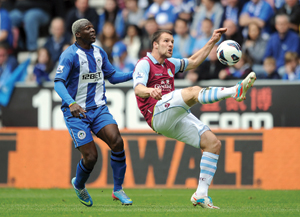Editor’s note: This is the first of a two-part column about sports sponsorship.
There’s a song by Mary Chapin Carpenter called “I Feel Lucky,” where she notes in the lyrics that “the stars might lie, but the numbers never do.” We wondered if the same axiom held for discussions about sports sponsorship in North America. Is it possible the numbers are lying?
On one hand, the annual IEG pronouncement or the more detailed Sponsorium Report (which came out in February) have suggested more money is being spent on sponsorships every year. The Canadian Sponsorship Landscape Study, now collecting data for its extensive seventh edition, says the same and emphasizes sponsorship’s growth (up 43 percent since 2006) despite tightened marketing budgets in the post-2008 global banking recession era.
However, this growth in sponsorship is not necessarily the same for sports as it might be for sponsored cause-marketing, festivals/fairs (annual events), concerts, education or the arts. In fact, Sponsorium notes the fastest-growing sector of sponsorship was trade shows (up 40 percent) and that sports partnerships were declining in their share of the sponsorship market.
This finding is backed by CSLS, which notes that other areas — primarily festivals (up 12 percent change in 2012 versus 2011) — have been taking a larger chunk of the sports sponsorship’s (down 13 percent) slice of the pie. Further, sponsors are telling us (through their actions) that their sweet-spot for ROI is also moving, with festivals tying professional sports as the top source of acceptable ROI for properties, according to the CSLS in 2012. Up to that point, professional sports had always held top billing.
Granted, more money is still spent on sports sponsorships than in any other area, but no one working in sports should neglect the fact that sports’ share of the sponsorship investment graph is shrinking. It’s a lot like schools and sports clubs a few years back thinking there were no problems with youth physical inactivity and membership rates because there was a bulge created by baby boomers’ kids that was hiding certain realities.
In the same way, sponsorship numbers in sports remain healthy and are even growing slightly thanks to the overall growth of sponsorship. But just like sports clubs needed to worry as Gen Xers chose less active lifestyles and didn’t back-fill their ranks with offspring, sports properties need to seriously look at arts, festivals, events and causes as their competitors for corporate dollars and creatively up the ante.
But let’s be clear. We’re not shouting “the sky is falling,” but rather we’re observing unusual atmospheric conditions.
So here are two questions to consider: Is the current North American sports landscape oversaturated? And, given that the majority of sporting mega-events will take place in other parts of the world for the next decade (Olympics, FIFA World Cup, Rugby World Cup and basketball world championships), is it possible less money will be spent on North American sports (per global capita) than in other parts of the world or even when compared to other forms of sponsorship?
Perhaps.
And isn’t it possible that in an age of environmental uncertainty, that sponsors have been modestly successful at signing long-term contracts with their mega-event (or mega-league) partners allowing for a true “smoothing” of their cash outlay?
 |
There’s no shortage of sponsorship revenue for the EPL, but smaller properties are attracting greater sponsor interest.
Photo by: GETTY IMAGES
|
We went back to recheck some numbers.
The English Premier League reportedly will increase sponsorship income by 50 percent during the next four years. And that position (for 2013-16) represents a 106 percent increase versus the four-year window of 2007-10. No “skyfall” over there.
Interestingly, the CSLS (as a representative sample of sponsors, properties and agencies) tells us annually that the vast majority of sponsorship spending is not on the mega-properties but on hundreds of national, regional and local properties. In fact, some 70 percent of sports sponsorship spending is on these types of smaller partners. And there, we believe, the rubber has left the road.
Properties are telling researchers that sponsorship works best when they are able to touch people, have potential customers experience their products and services and find platforms that relate to them in a meaningful (i.e., local) way.
So maybe the numbers don’t lie … or haven’t misled us at all. But the sports industry may do well to listen to what’s going on out there. If you are a sports sponsorship seller, it may be time to hone your sponsorship sales strategies and take back market share from other non-sports properties.
We know sponsorship, in general, and sports sponsorship, specifically, works. We know it performs well in tight (or boom) economies. But at the moment, it is very possible sports are getting beaten off the bounce by other sector types.
Certainly, it’s not our job, nor the job of this magazine or any single sports property, to wave the flag for sports sponsorships. But if we had our way, we’d ask who is keeping an eye on the weather charts or compiling the next decade’s almanac.
From where we sit, sponsorship sector dominance for sports may be up for grabs in a few years, and if that day arrives the numbers won’t lie. Rather, they will tell all.
Rick Burton (rhburton@syr.edu) is the David B. Falk Professor of Sport Management at Syracuse University. Norm O’Reilly (norman.oreilly@ottawa.com.ca) is a professor of sport business at the University of Ottawa and senior adviser at TrojanOne.





